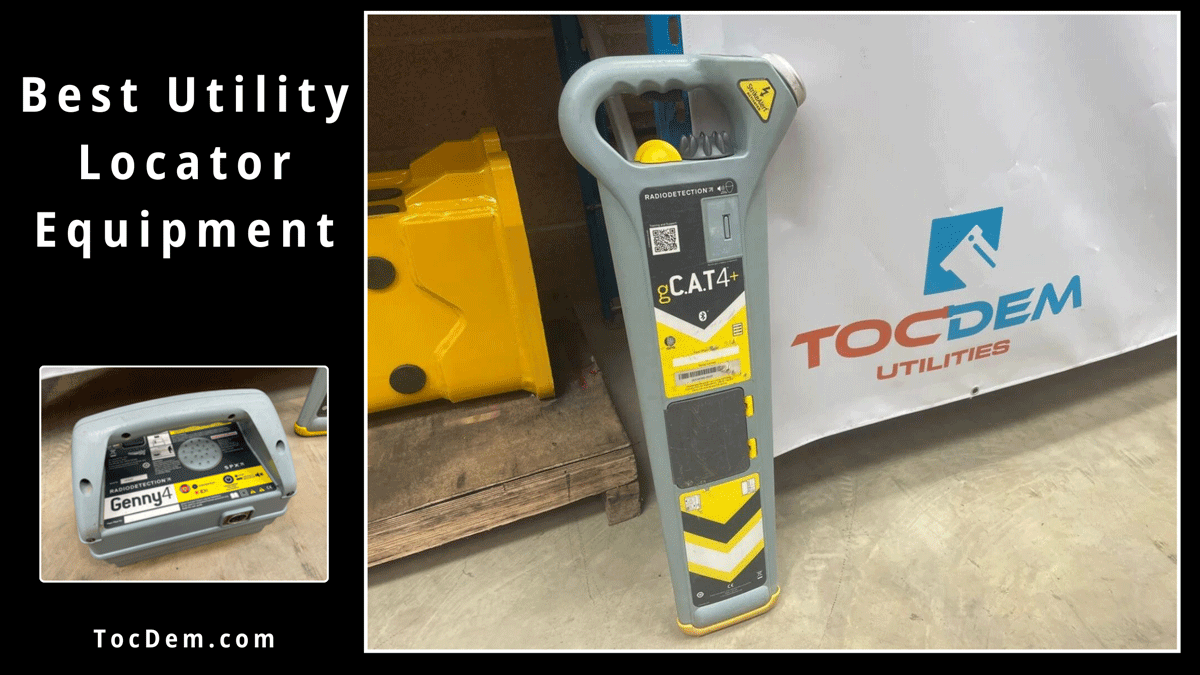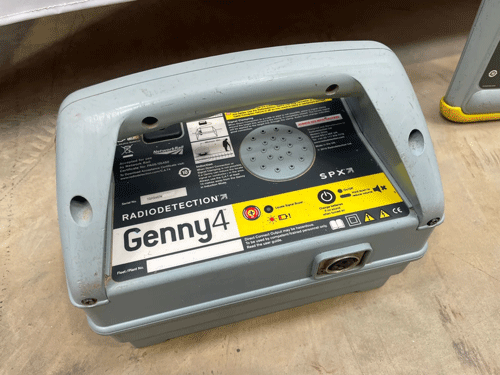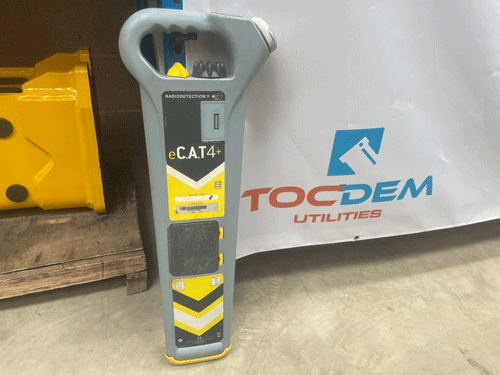
Are you looking to avoid costly mishaps during excavation projects? The best utility locator equipment will offer a stark contrast between a smooth operation and potential disasters. With the latest cutting-edge technology in these devices and skilled professionals, they will ensure accurate detection of underground utilities, saving you time, and money.
By pinpointing the exact location of buried pipes, cables, and other infrastructure, smart utility locating equipment will help prevent accidental damages and ensure a safe working environment.
Cable locators (underground utility locator equipment) are devices used to detect and map underground utilities like cables, pipes, and other infrastructure. Cable locators play a crucial role in preventing accidental damage during excavation projects.
Common underground utility locator tools include ground penetrating radar (GPR), electromagnetic locators, and acoustic pipe locators. These tools are essential across industries such as construction, landscaping, and utility maintenance.
Tools such as the CAT and Genny operate based on the principles of electromagnetic induction and ground conductivity. They function by emitting signals into the ground and detecting reflections from underground utilities.
Using utility locators enhances safety by preventing accidental hits on buried utilities, reducing risks of injuries and service disruptions. They help avoid costly damages to infrastructure, saving time and resources for repair.


Active locators transmit signals into the ground to detect utilities such as pipes and cables. These devices emit electromagnetic frequencies, allowing users to pinpoint the exact location of buried infrastructure. The advantages of active locators include their ability to provide real-time data, making them ideal for accurate utility mapping.
Common applications where active locators excel include construction sites, where accuracy is crucial to avoid damaging existing utilities. They are also widely used by utility companies during maintenance and repair work to streamline operations efficiently.
Passive locators, on the other hand, detect existing signals emitted by utilities themselves. These devices do not require an external power source but rely on the natural frequencies produced by buried infrastructure. Passive locators are most effective in locating live power lines or telecommunication cables where active signal transmission is not feasible.
Despite their advantages, passive locators have limitations compared to active ones. They are less precise in pinpointing utility locations and may struggle in environments with significant signal interference.
Here are the primary types of equipment used for underground cable detection:
When selecting the best utility locators on the market you must prioritise features that optimise performance. Look for user-friendly interfaces that simplify operations. Portability is also crucial for manoeuvring in various terrains and environments.
While durability and battery life are essential for prolonged fieldwork. Many factors can influence the cost of your preferred underground utility locator equipment. As with many buying decisions, you must consider the trade-offs between price and functionality.
Higher-priced models may offer advanced features, while budget-friendly options may still provide basic functionalities that you’ll need for this type of work. You can also consider hiring a cable avoidance tool, from us at TocDem Utilities, with options for daily, weekly or yearly leases.
Here are several optimal underground utility locator tools recommended by TocDem that will help to enhance the safety and efficiency of your next projects.
The LMX200 Ground Penetrating Radar (GPR), is a revolutionary underground utility locating tool that empowers you to see beneath the surface with unparalleled clarity.
This advanced technology goes beyond traditional utility locating, enabling you to confidently detect a wide range of subsurface features, including:
When it comes to accurately locating buried utilities, Radiodetection’s eCAT and gCAT cable locators stand out as industry leaders. They offer professionals in construction, utility maintenance, and landscaping the precision and reliability needed to work safely.
Here’s a comparison between the Radiodetection eCAT4 and gCAT4+ Cable Avoidance Tools, highlighting their key differences:
The eCAT4+ is renowned for its high precision in detecting underground utilities. Its user-friendly interface streamlines the locating process, while its lightweight design ensures comfortable use even during long workdays.
| Features | eCAT4+ | gCAT4+ |
|---|---|---|
| Core Functionality: | Rapid surveying and precise pinpointing of Genny, Power, and Radio signals | Same as eCAT4, plus enhanced depth estimation |
| Data Logging: | On-board data acquisition for identifying training needs | Stores over a year’s worth of key measurements and operational modes |
| GPS Integration: | No built-in GPS | Built-in GPS for positional data logging and mapping |
| SWING Warning: | Alerts the operator to incorrect usage patterns | Same as eCAT4, plus stores SWING data in the log |
| StrikeAlert™: | Not included | Warns of shallow buried utilities for increased safety |
| Connectivity: | eCert™ for online calibration validation | Same as eCAT4, plus Bluetooth (for future use) |
| Additional Features: | Dynamic overload protection, Service Due indicator | Same as eCAT4, plus CALSafe™ for enhanced safety |
The gCAT4+ is a robust and dependable cable locator designed for challenging environments. Its advanced technology provides exceptional depth detection and signal clarity, ensuring precise utility location even in complex situations.
Both the Radiodetection eCAT4+ and gCAT4+ locators leverage innovative technologies to deliver quick, accurate, and reliable results. These tools are essential for anyone working near buried utilities, helping to save time, resources, and most importantly, lives.
Choose the eCAT4+ tool for its user-friendly interface and lightweight design, or opt for the gCAT4+ when you need enhanced depth detection and rugged durability. No matter your needs, these Radiodetection tools are perfect to keep your projects on track and your team safe.
The Radiodetection RD8200SG is the pinnacle of precision locating, seamlessly integrating utility mapping and locating into one powerful tool. Experience survey-grade accuracy while efficiently building a comprehensive inventory of buried infrastructure, all in a single operation.
Map It Your Way:
Designed for the Field:
Benefits for Locate Experts:
Benefits for Mapping Experts:
Ergonomic and Built to Last:
The RD8200SG is the ultimate tool for professionals who demand the best in both locating and mapping. Experience the power of precision and efficiency.
The RD7200 is the ultimate precision locator, engineered for accuracy and efficiency in everyday use. This multi-functional tool is your no-compromise solution for locating and marking buried utilities quickly, safely, and with unwavering confidence.
Unmatched Versatility:
Accuracy and Ease of Use:
Built to Last:
Safety & Confidence:
The RD7200 is the ideal cable locating tool for any industry where accurate and reliable utility locating is paramount. Experience the difference with this precision locator, designed to make your job easier, safer, and more efficient.
Renting a cable underground utility locator offers flexibility for short-term projects, allowing users to access advanced technology without a long-term commitment. This option is ideal for occasional use or one-time projects. However, renters may face challenges due to limited familiarity with specific equipment models, leading to potential inefficiencies during operations.
When considering renting utility locators, it is essential to assess the project’s duration and frequency of use. Short-term projects benefit from the cost-effectiveness of rentals, eliminating the need for upfront investments in equipment.
For example, construction companies working on temporary sites can save money by opting for rental solutions instead of purchasing expensive locators.
Purchasing utility locators provides long-term convenience and accessibility, ensuring that users have the necessary equipment readily available whenever needed.
Buying equipment offers familiarity with specific models, allowing operators to maximise efficiency and accuracy in utility locating tasks. However, the initial cost of purchasing locators can be substantial, requiring a significant financial investment upfront.
For organisations or professionals engaging in frequent utility locating tasks, buying equipment proves to be a cost-effective solution in the long run. By owning the equipment, users can avoid recurring rental expenses and have full control over maintenance and upgrades.
In scenarios where projects are ongoing or require consistent utility locating services, buying locators becomes the more advantageous choice.
When comparing the costs of renting and buying an underground wire locator tool, several factors come into play. Rental fees typically involve daily, weekly, or monthly rates, which can accumulate over time for extended projects.
On the other hand, buying equipment incurs a one-time cost but may require additional expenses for maintenance and repairs in the future.
To determine the most cost-effective option, users should consider the frequency of use, project duration, and budget constraints. Implementing a thorough cost analysis can help in evaluating the total expenses associated with both renting and buying these smart utility locator solutions.
Users can explore savings strategies such as bulk-purchasing discounts or leasing options to optimise their utility locating investments.
In conclusion, understanding the best utility locators, choosing the best one for your needs, and utilising it effectively are crucial steps in ensuring safety and efficiency when working around buried utilities. Whether you opt to hire one from reputable companies like TocDem or buy a new cable locator outright, remember to always prioritise safety when using these tools.
Utility locators detect underground utilities such as pipes and cables before excavation, preventing damage and ensuring safety.
Modern utility locators can provide accurate results within a range of a few inches to a few feet, depending on the type of locator and the conditions of the site.
Utility locators can detect common utilities like water pipes, gas lines, and electrical cables. However, they may be unable to locate non-metallic or abandoned lines effectively.
While some basic models are user-friendly, proper training is recommended to ensure accurate readings and the safe operation of advanced utility locators.
When choosing a cable locator it is important to consider factors such as the types of utilities you need to locate, depth capabilities, accuracy, ease of use, additional features like GPS integration, and overall reliability when selecting one.
To find buried pipes with a cable locator, follow these steps:
Select the right locator: Choose one compatible with the pipe material and expected depth.
Prepare the area: Clear debris and gather information about the pipe location.
Connect transmitter (if applicable): Attach to pipe or use induction mode for non-metallic pipes.
Set the frequency: Choose the appropriate frequency based on pipe type and depth.
Scan the area: Slowly sweep the receiver, listening for signals or watching the display.
Pinpoint and mark: Once detected, move perpendicular to the pipe to find its centre and mark it.
Verify and mark: Confirm location and depth using different frequencies or depth estimation.
Helpful Guides and More Products For Locating Cables